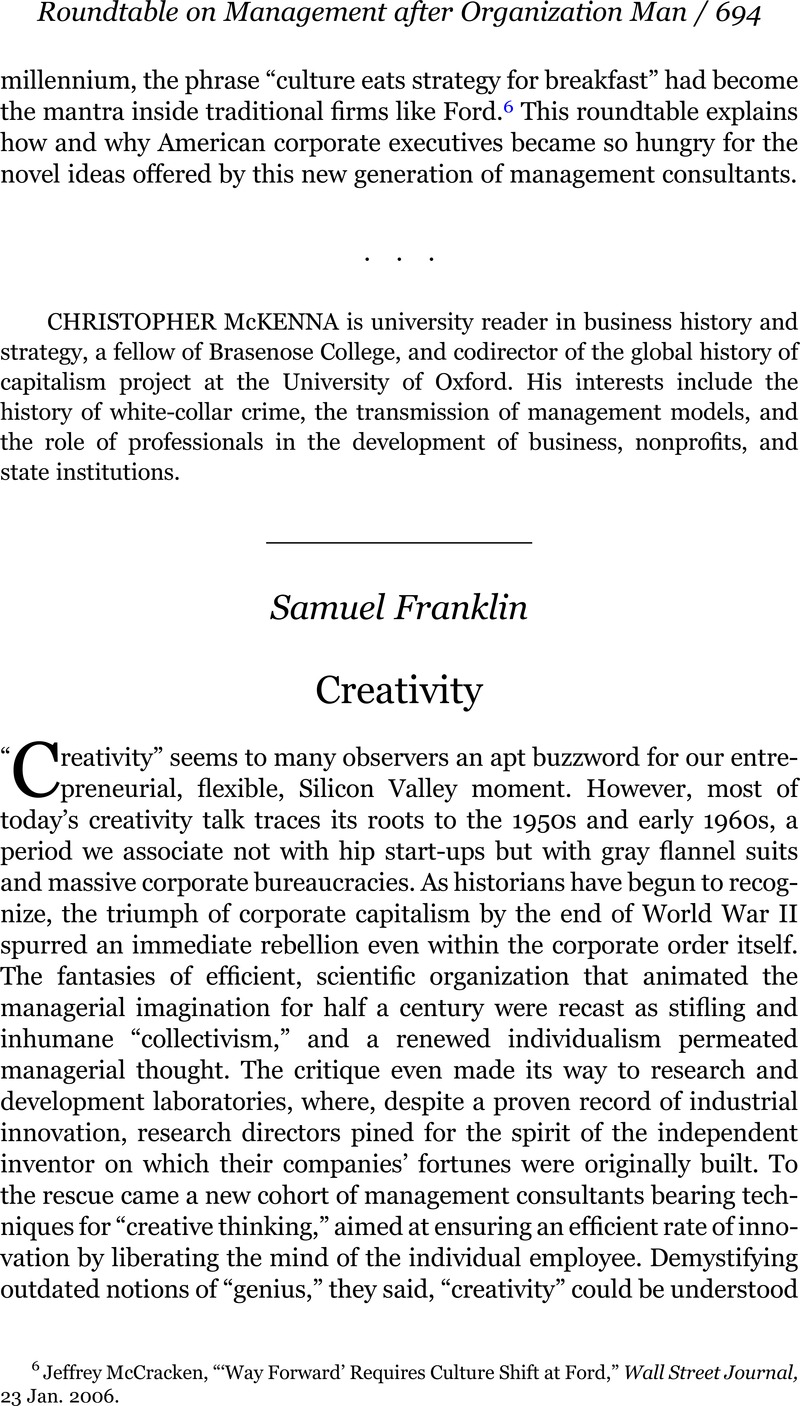
7 Drucker, Peter F., The Practice of Management (New York, 1954)Google Scholar; Schumpeter, Joseph A., Capitalism, Socialism and Democracy, 3rd ed. (New York, 2008)Google Scholar.
8 On the importance of new consumer products to postwar corporate growth, see Chandler, Alfred D. Jr., “The Competitive Performance of U.S. Industrial Enterprises since the Second World War,” Business History Review 68, no. 1 (1994): 1–72 CrossRefGoogle Scholar; and Chandler, Alfred D. Jr., “Commercializing High-Technology Industries,” Business History Review 79, no. 3 (2005): 595–604 CrossRefGoogle Scholar.
9 Whyte, William, The Organization Man (New York, 1956), 217 Google Scholar.
10 Schumpeter, Capitalism, Socialism and Democracy, 156.
11 Thompson, Victor A., “Bureaucracy and Innovation,” Administrative Science Quarterly 10, no. 1 (1965): 1–2, doi:10.2307/2391646 CrossRefGoogle Scholar.
12 On the psychological study of creativity in postwar America, see Cohen-Cole, Jamie, “The Creative American: Cold War Salons, Social Science, and the Cure for Modern Society,” Isis 100, no. 2 (2009): 219–62CrossRefGoogle Scholar; Cohen-Cole, Jamie, The Open Mind: Cold War Politics and the Sciences of Human Nature (Chicago, 2014)Google Scholar; Bycroft, Michael, “Psychology, Psychologists, and the Creativity Movement: The Lives of Method Inside and Outside the Cold War,” in Cold War Social Science: Knowledge Production, Liberal Democracy, and Human Nature, ed. Solovey, Mark and Cravens, Hamilton (New York, 2012)Google Scholar; Ogata, Amy Fumiko, Designing the Creative Child: Playthings and Places in Midcentury America (Minneapolis, 2013)CrossRefGoogle Scholar; van Eekelen, Bregje, “The Social Life of Ideas: Economies of Knowledge” (PhD diss., University of California, Santa Cruz, 2010)Google Scholar; Brouillette, Sarah, Literature and the Creative Economy (Stanford, 2014)CrossRefGoogle Scholar; and Serraino, Pierluigi, The Creative Architect: Inside the Great Midcentury Personality Study (New York, 2016)Google Scholar.
13 Steiner, Gary A., The Creative Organization (Chicago, 1965), 8 Google Scholar. The quotations that follow are taken from Steiner's introduction to the volume, in which he endeavors to summarize and generalize the common beliefs of a panel of experts called to discuss creativity in the corporate industrial context at the University of Chicago Graduate School of Business in 1962, sponsored by the McKinsey Foundation of Management Research. The participants included Frank Barron, Morris Stein, Jerome Bruner, and Milton Rokeach, who were among the most influential experts on creativity in the 1950s and 1960s, as well as the famous ad man David Ogilvy and transistor entrepreneur and former Bell Laboratories scientist William Shockley. Steiner's characterization of creativity used here is an accurate representation of the expert discourse.
14 Ibid., 10.
15 Ibid., 14.
16 For two contemporary critiques that point out the conflation of “creativity” as a personality type and “creativity” as a record of inventiveness in the industrial arts, see McNemar, Quinn, “Lost: Our Intelligence? Why?” American Psychologist 19, no. 12 (1964): 871–82CrossRefGoogle Scholar; and Hudson, Liam, Contrary Imaginations: A Psychological Study of the Young Student (New York, 1966)Google Scholar.
17 Cohen-Cole, The Open Mind, 45 (emphasis in original).
18 Steiner, Creative Organization, 11–12.
19 Ibid., 21.
20 Thompson, “Bureaucracy and Innovation,” 1.
21 Steiner, Creative Organization, 13.
22 Ibid., 8; for the basics of the Synectics method, see Gordon, William J. J., Synectics: The Development of Creative Capacity (New York, 1961)Google Scholar; and Prince, George M., The Practice of Creativity: A Manual for Dynamic Group Problem Solving (New York, 1970)Google Scholar.
23 “Synectics: Inventing by the Madness Method,” Fortune, Aug. 1965.
24 Ibid.
25 “Synectics: A New Method for Developing Creative Potential,” Synectics, Inc. promotional brochure, ca. 1962, box 29, folder 8, United Shoe Machinery Corporation Papers, National Museum of American History, Washington, D.C.
26 Rogers, Carl, “Toward a Theory of Creativity,” ETC: A Review of General Semantics 11, no. 4 (1954): 249–60Google Scholar; Maslow, Abraham H., The Maslow Business Reader, ed. Stephens, Deborah C. (New York, 2000)Google Scholar.
27 McGregor, Douglas, The Human Side of Enterprise (New York, 1960)Google Scholar.